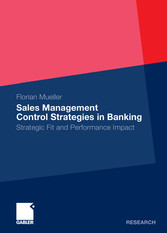Suchen und Finden
Mehr zum Inhalt

Sales Management Control Strategies in Banking - Strategic Fit and Performance Impact
Acknowledgements
7
Table of Contents
9
List of Figures
13
List of Tables
16
List of Equations
18
List of Abbreviations and Symbols
19
1 Introduction
21
1.1 Problem Definition
21
1.2 Research Objectives and Contribution to Literature
24
1.3 Structure of Analysis
27
2 Banking in Germany
31
2.1 Overview of the German Banking Market
31
2.2 The Three Pillars of the German Banking System
35
2.2.1 Private Commercial Banks
36
2.2.2 Savings Bank Group
37
2.2.3 Cooperative Banking Group
39
2.3 Segmentation of the Banking Industry
41
2.3.1 Retail Banking
41
2.3.2 Private Banking
43
2.3.3 Corporate Banking
45
2.4 Current Development
47
2.5 Summary
55
3 Terminological, Conceptual, and Theoretical Basics
59
3.1 Strategy and Strategic Management
59
3.1.1 Concept of Strategy
60
3.1.1.1 Evolution and Definition
60
3.1.1.2 Levels of Strategy
65
3.1.1.3 Banking Business Strategy
67
3.1.2 Strategic Management
70
3.1.2.1 Evolution and Definition
70
3.1.2.2 Configurational School
80
3.1.2.2.1 Fit Concept
80
3.1.2.2.2 Development of Configurations
85
3.2 Sales Management Control
86
3.2.1 Evolution and Definition
86
3.2.2 Formal Management Controls
90
3.2.2.1 Behavior Control
91
3.2.2.2 Compensation Control
94
3.2.3 Informal Management Controls
98
3.2.3.1 Self Control
98
3.2.3.2 Professional Control
99
3.2.3.3 Cultural Control
101
3.2.4 Underlying Theories
102
3.2.4.1 Applicability of Theories
102
3.2.4.2 Transaction Cost Analysis
103
3.2.4.3 Agency Theory
107
3.2.4.3.1 Evolution and Definition
107
3.2.4.3.2 Positivist Agency Theory
110
3.2.4.3.3 Principal-Agent Theory
111
3.2.4.4 Organizational Control Theory
115
3.3 Internal and External Influencing Variables
121
3.3.1 Organizational Structure and Characteristics
121
3.3.1.1 Organizational Culture
121
3.3.1.2 Organizational Centralization
124
3.3.2Environmental Parameters
127
3.4 Performance
131
3.4.1 Sales Organization Outcomes
132
3.4.2 Salesperson Behavioral Performance
133
3.4.3 Salesperson Outcome Performance
133
3.5 Summary
135
4 Theoretical Framework and Hypotheses
140
4.1 Theoretical Framework
140
4.2 Theoretical Hypotheses
145
4.2.1 Strategy Control Fit
145
4.2.2 Organization Control Fit
150
4.2.3 Influence of the Environment on Configurations
163
4.3 Model Summary
177
5 Empirical Data
183
5.1 Data Gathering
183
5.3 Operationalization of the Constructs
194
5.3.1 Overview of the Operationalization Approach
195
5.3.2 Sales Management Control Strategy
201
5.3.3 Bank Strategy
206
5.3.4 Organization-Specific Characteristics
209
5.3.5 Environmental Parameters
213
6 Empirical Analysis of the Theoretical Model
219
6.1 Analysis of the Relationships in the Theoretical Model
219
6.1.1 Criteria for the Evaluation of PLS Models
219
6.1.2 General Evaluation of the Theoretical Model
222
6.1.3 Strategy Control Fit
224
6.1.3.1 Assessment of Predictability
224
6.1.3.2 Testing of Research Hypotheses
226
6.1.4 Organization Control Fit
231
6.1.4.1 Assessment of Predictability
231
6.1.4.2 Testing of Research Hypotheses
234
6.1.5 Environmental Influence on Configurations
243
6.1.5.1 Assessment of Predictability
243
6.1.5.2 Testing of Research Hypotheses
245
6.2 Analysis of the Performance of Configurations
251
6.2.1 Identification of Ideal Empirical Profiles
251
6.2.2 Performance Impact of Adherence to Ideal Empirical Profiles
255
6.2.3 ence of Ideal Empirical Profiles with Theoretical Relationships
258
6.2.3.1 Strategy Control Fit
258
6.2.3.2 Organization Control Fit
265
6.2.3.3 Environmental Influence on Configurations
273
6.3 Discussion of the Results
278
7 Conclusion
282
7.1 Final Comments and Recommendations
282
7.2 Implications for Future Research
289
Bibliography
292
Appendices
354
Index
395
Alle Preise verstehen sich inklusive der gesetzlichen MwSt.













